Editor’s note: This article is the second in a series of three, part of a study exploring the structural factors driving outbound student mobility in Nigeria and Ghana, within the larger context of developments in sub-Saharan Africa. Read the first article in the series.
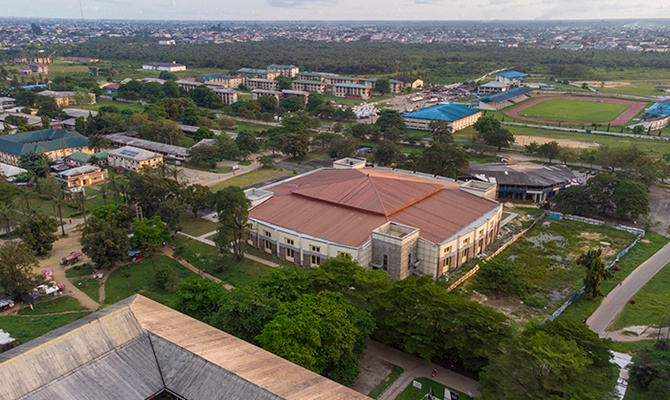
Nigerian students are increasingly seeking educational opportunities abroad, with nearly 85,000 enrolled in tertiary programs globally in 2021, including a growing number in China.
Nigeria is the most populous country in Africa. About 220 million people call Nigeria home. It is the continent’s second-largest economy and has been the top sender of international students in sub-Saharan Africa (SSA) for years. Outbound mobility has grown quickly: Over the past two decades, the number of Nigerians enrolled in tertiary degree programs in other countries quadrupled, reaching 84,797 in 2021. The fact that Nigeria is an English-speaking country with colonial ties to the United Kingdom means that Nigerian students have historically preferred Western study destinations. The U.K., the United States, and Canada registered as top choices in 2021, per UNESCO statistics.
In addition, Nigerian students increasingly learn in China. China does not share data with UNESCO, neither has it published recent international student statistics. But according to the Chinese Ministry of Foreign Affairs there were more than 60,000 African students in China in 2016 already, including some 8,600 Nigerians. To put these numbers in perspective, many of these students are likely enrolled in short-term programs and vocational training rather than in full-fledged tertiary degree programs.
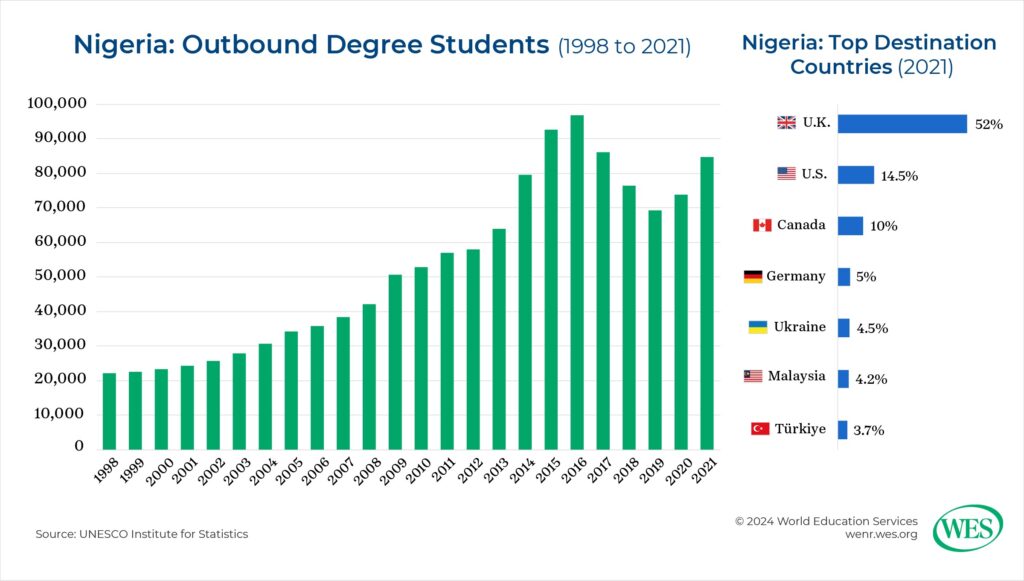
Students in the U.S. and Canada
Since 2021, the number of Nigerian students in the U.S. and Canada has grown at an exceptionally fast rate. The most recent visa statistics reflect a 56 percent increase in the number of Nigerian students in the U.S., to more than 23,000 in 2024. In Canada, Nigerian international student applications skyrocketed by 260 percent—or 32,000 students—from around 13,500 in 2021 to close to 46,000 in 2023.
The spike in Canada was likely driven, in part, by Nigeria Student Express—a new visa stream introduced in 2020 whose financial requirements were tailored to conditions in Nigeria. Like the Student Direct Stream, a visa program for which Nigeria was not eligible, Nigeria Student Express facilitated application processing times. The new visa stream was promoted at EduCanada fairs in Nigeria. Notably, student visa approval rates for Nigerians doubled, jumping from only 17 percent in 2019 to 34 percent in 2021. In addition, pent-up demand after the pandemic may have played a role, as has the introduction of more restrictive visa rules in May 2023 in the U.K., the top destination country for Nigerian students.
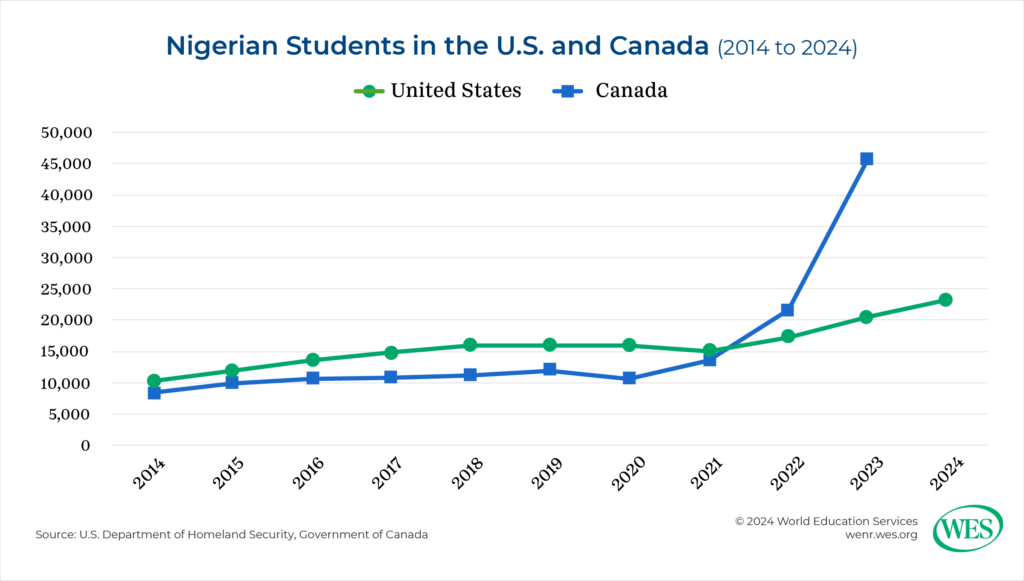
Nigeria will be one of the most important recruitment markets for international students in the next decades. It is projected to become the world’s third most populous country by 2050 with about 377 million people, 53 percent of whom will be under the age of 25.
University seats and quality jobs are extremely scarce in the country, and as a result, outmigration is widespread. The so-called Japa syndrome—the mass exodus of Nigerian young people to Western countries—is so omnipresent that 7 out of 10 Nigerians would leave the country if given the opportunity, according to recent surveys.
Other surveys found that close to half of polled Nigerians planned to leave the country within the next five years, primarily to access job opportunities and educational programs, as well as to reunite with family. Escape from political violence was also cited as a reason. The U.S. was the preferred destination, alongside countries in Europe and the Middle East.
The reality is that options in Nigeria are limited. Only about 12 percent of university-age people currently participate in higher education. That is slightly above average in SSA but compares with 27 percent in India.
The Nigerian state cannot accommodate the country’s exploding demand for higher education, and this will be true for the foreseeable future. The number of university students in the country has roughly tripled to about 2.2 million over the past two decades—a massive spike. But the number of high school students simultaneously grew at a much faster pace, to about 6 million, which means that the university system is stretched beyond its capacity to absorb overall demand.
University admissions are consequently highly competitive. Only one-third of the 1.8 million applicants who applied through Nigeria’s centralized university admission system in 2022 were admitted. That means that there are currently about 1.2 million young people locked out of the system each year. In popular disciplines like medicine, the rejection rates are exponentially higher.
Education spending in Nigeria has consistently been well below the threshold of 15 to 20 percent of total government expenditures that UNESCO recommends for developing economies. The most recent 2024 federal budget allocated 7.9 percent of expenditures to education. The public university system is critically underfunded by all accounts. Large-scale strikes and protests related to low pay for university instructors and dilapidated infrastructure have rocked Nigerian public universities and disrupted education for years. The current level of federal higher education spending is barely sufficient to maintain the status quo, let alone to fund a major expansion of the system or implement substantial quality improvement initiatives.
Provider Landscape
Nigeria has the largest higher education system in Africa. The number of universities in the country has jumped from 41 in 1998 to 273 in 2024, and the government plans to establish another 47 public higher education institutions in the coming years.
However, as in several other developing countries with budgetary constraints, such as India, most of the newly established universities are private institutions. Private education has been permitted on a larger scale by the Nigerian government since the late 1990s. But whereas private higher education has played a pivotal role in expanding capacity in India, the entry of private providers in Nigeria has thus far not translated into major enrollment gains. While there are successful private institutions, such as the top-ranked Covenant University with some 9,000 students, most of the 148 private institutions in Nigeria are smaller niche providers that enroll less than 7 percent of all tertiary students combined. Comparatively high tuition fees at these institutions are one factor that impedes the growth of the private sector.
Open distance learning and online education are considered cost-effective mechanisms to widen access to higher education and are actively pursued in Nigeria. The National Open University of Nigeria, a public distance education provider, is now the largest academic institution in Nigeria with over 100,000 students. Online education, including by foreign providers, is likely to expand substantially as the digital infrastructure of Nigeria matures.
The current government also seeks to increase transnational university partnerships with foreign institutions. Several Indian universities reportedly plan to set up branch campuses in Nigeria in the near future. Enrollments by Nigerians in U.K. TNE programs quadrupled from close to 10,700 in 2018 to over 44,000 in 2022, partially driven by travel restrictions during the pandemic.
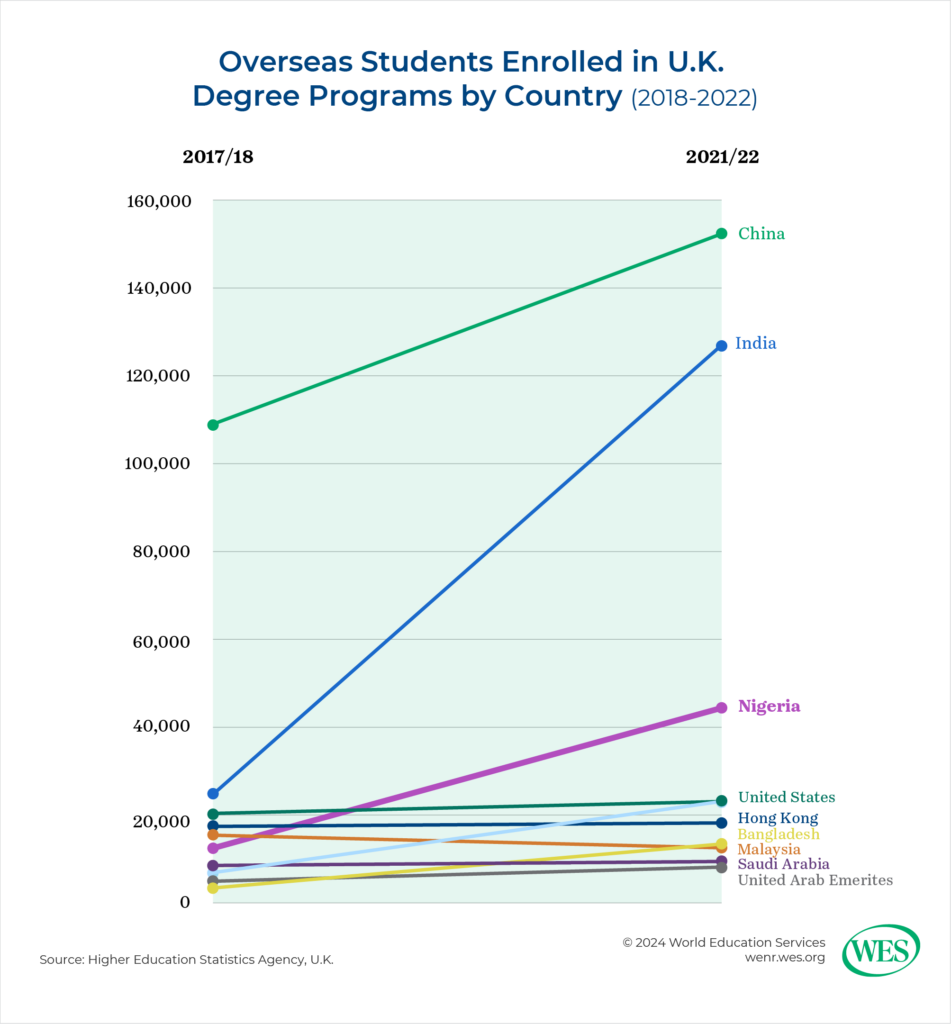
That said, it appears unlikely that these developments will significantly ease Nigeria’s capacity crisis and stem the accelerating outflow of students in the near term. To a large extent, outbound mobility in Nigeria needs to be understood as a form of “education migration.” A 2022 international student survey by the U.K. Universities and Colleges Admissions Service, for example, showed that Nigerians prioritize employment opportunities more than students from India or other countries do. More than half of Nigerians said they chose to study abroad to seek post-study work; 80 percent wanted to better their career prospects.
In the U.K., the abolishment of post-study work options for international students in 2012 resulted in a significant decrease in Nigerian applications, whereas the re-introduction of these options in 2019 was followed by a 335 percent spike in Nigerian applications over a span of two years. Most recently, when the U.K. announced that it would prohibit international bachelor and master students from bringing their family members with them to the country, demand by Nigerian students plummeted again and started to shift towards countries perceived as more immigrant-friendly.

Economic Factors
The Nigerian economy does not provide enough skilled jobs for the 600,000 graduates the country’s higher education system produces each year. By some accounts, 39 percent of bachelor’s degree holders were unemployed in 2020, while fully 59 percent of graduates with a vocationally oriented Higher National Diploma were out of work. Unemployment was much lower for graduate degree holders, but graduate programs are in short supply in Nigeria, enrolling only some 250,000 students in 2023. For the foreseeable future, urban middle-class young people in cities like Lagos are all but certain to exit the country in large numbers. Graduate degree programs in particular will continue to be a draw for Nigerian students. About 67 percent of Nigerian students in the U.S. are enrolled at the postgraduate level.
On the other hand, limited purchasing power and funding opportunities hamper outbound mobility. Nigeria is said to have Africa’s fastest-growing middle class. Most approximations of its size are dated, but the World Bank estimated in 2015 that 20 percent of Nigerians belonged to the middle class. Most of them are educated professionals formally employed in private industry and public service in Lagos or other major cities, like Ibadan or Port Harcourt. However, income levels within this group are modest by Western standards. A recent survey found that only 6 percent of Nigerians earn more than 1 million Nigerian naira, or $680 a month at current exchange rates. Few have emergency savings; many middle-income households are vulnerable to falling into poverty in the event of an economic shock. One in five of those able to save money said they were saving for “japa”; 49 percent said that relocating to another country was their top financial goal.
At present, Nigeria faces one of the worst economic crises of its recent past. The country’s inflation rate has been high for years, averaging 13 percent between 2012 and 2022, but it skyrocketed to over 31 percent in 2024. The depreciation of the country’s currency, the naira, makes it hard for aspiring international students to go abroad since it increases the costs they incur for travel, housing, and tuition in other countries.
The Nigerian government has long artificially elevated the naira’s exchange rate by pegging it at a fixed rate to the U.S. dollar but had to devalue the currency repeatedly in recent years to attract more foreign investment. After the latest currency devaluation in early 2024, the naira slipped by 60 percent against the U.S. dollar within a few months. As shown in the chart below, such rapid exchange rate shifts are closely correlated to decreases in outbound student flows. As of May 2024, there were already reports of Nigerian students being ordered to leave the U.K. because they were falling behind on tuition payments due to the depreciation of the naira.
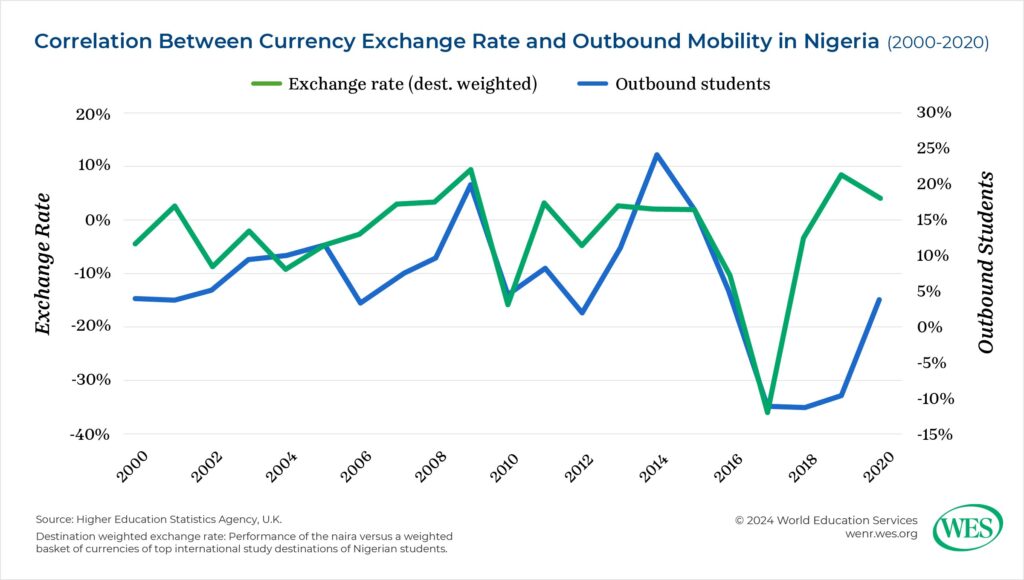
In conclusion, Nigeria is the most important recruitment market in sub-Saharan Africa. It has massive growth potential due to push factors like admissions bottlenecks, lack of viable employment opportunities, and strong emigration sentiments among the population. However, outbound student flows are mitigated by economic uncertainty, so that fluctuations in application volume are likely. In the short term, it remains to be seen if the strong push factors in the country can override the adverse effects of the huge depreciation of the naira against the U.S. dollar.
#International #Student #Mobility #SubSaharan #Africa #Trends #Nigeria #Part










